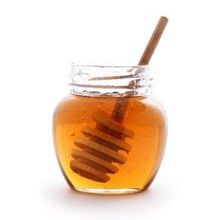Historical medicine suggests a new way to use modern treatments
12 July 2023

Could a combination of honey and vinegar, be an old, yet new, way of treating persistent infections?
The mixture of honey and vinegar, also known as oxymel, has been used as a medical treatment throughout history and now scientists have established that this combination could have modern applications in the treatment of wounds.
New research, published in Microbiology, is the first comprehensive exploration of how the mixture could be applied to modern medicine and improve treatments for infections.
Bacterial infections can be difficult to treat, particularly when they are protected within a biofilm. A biofilm is a complex system of bacteria which can attach tightly to surfaces, like flesh in a wound infection. Bacteria which are protected in a biofilm are difficult to kill, and treatments today are not always effective at removing them.
Previous research has shown how effective some natural remedies can be at treating infections. Manuka honey has been proven to possess antimicrobial properties and aid wound healing and vinegar is also proven to be a useful antiseptic.
Doctors have utilised this information in medicine today. While they use manuka honey to treat antibiotic resistant infections they only use acetic acid, the active component of vinegar and do not currently combine the two.
Dr Erin Connelly, Dr Freya Harrison and their team from the University of Warwick are the first to explore what happens when both honey and vinegar are combined and applied to biofilms of bacteria grown in the laboratory.
Having identified the gap, researchers began by investigating the effects of combinations of two medical-grade honey ointments with natural vinegar or acetic acid. They wanted to find out how effective the treatment is at killing microbes, and which combination worked best.
They were also curious to know if whole vinegar is more antibacterial than just acetic acid. Dr Erin Connelly, a researcher on the study, said, “In our survey of premodern recipes we noticed a pattern of combining honey and vinegar to wash or dress wounds and swellings, and this inspired us to focus on that combination in our analysis.”
By comparing the use of vinegar and acetic acid alone, then in combination with medical-grade honey, the researchers found that it was specifically the combination of the two substances which was best. “We applied a low dose of honey, that alone didn’t kill the bacteria, and a low dose of acetic acid that also could not kill the bacteria alone,” according to Dr Harrison. “These doses are lower than those that wound care nurses currently use on patients. But when we put these low doses together, we saw a large number of bacteria dying which is really exciting. We really need to investigate whether combining these substances could help patients who are not responding to either substance used alone.”
The researchers also found that some natural vinegars had a greater ability to kill bacteria than an equivalent dose of pure acetic acid. In particular, pomegranate vinegars are interesting candidates for further study; these had strong antibacterial activity and, like acetic acid, had activity when combined with honey.
Whilst more research needs to take place to understand the mechanism and best dose combinations of the combined honey and vinegar, these promising results have proved exciting enough that the researchers now propose to take a modern version of oxymel into the clinical trial stage.
Professor Joseph Hardwicke, Consultant Plastic and Reconstructive Surgeon at University Hospitals Coventry and Warwickshire explains "This is an exciting area of research to use traditional remedies in the modern NHS. The burden of wound care and infections is increasing year by year, with causative conditions such as diabetes on the rise. Maybe the knowledge of our ancestors can be used to enhance the current care we can provide to our patients, at a lower cost.”
NOTES FOR EDITORS
The paper “Sweet and sour synergy: exploring the antibacterial and antibiofilm activity of acetic acid and vinegar combined with medical-grade honeys” by Freya Harrison, Anisa Blower, Christopher de Wolf and Erin Connelly is published in Microbiology at the following:
DOI: 10.1099/mic.0.001351
URL: https://www.microbiologyresearch.org/content/journal/micro/10.1099/mic.0.001351
To obtain an advance copy of the manuscript ahead of the lifting of the embargo please contact [email protected]
Funding information
The study was funded by a UKRI Future Leaders Fellowship awarded to E.C. MR/T020652/1. A.B. contributed to this research during her final-year research project for the MBio degree fin Biological Sciences at the University of Warwick, which provided additional funding for laboratory consumables. The authors acknowledge use of the Agilent 1260 infinity II Preparative HPLC system and training support provided by the WISB Research Technology Facility within the School of Life Sciences, University of Warwick.
About the Microbiology Society.
The Microbiology Society is a membership charity for scientists interested in microbes, their effects and their practical uses. It has a worldwide membership based in universities, industry, hospitals, research institutes, schools, and other organisations.
Find out more at microbiologysociety.org.
For further information please contact [email protected].
University of Warwick press office contact:
Annie Slinn
Communications Officer | Press & Media Relations | University of Warwick
Email: [email protected]
Image: Istock/KMNPhoto/Kuzmik_A.
